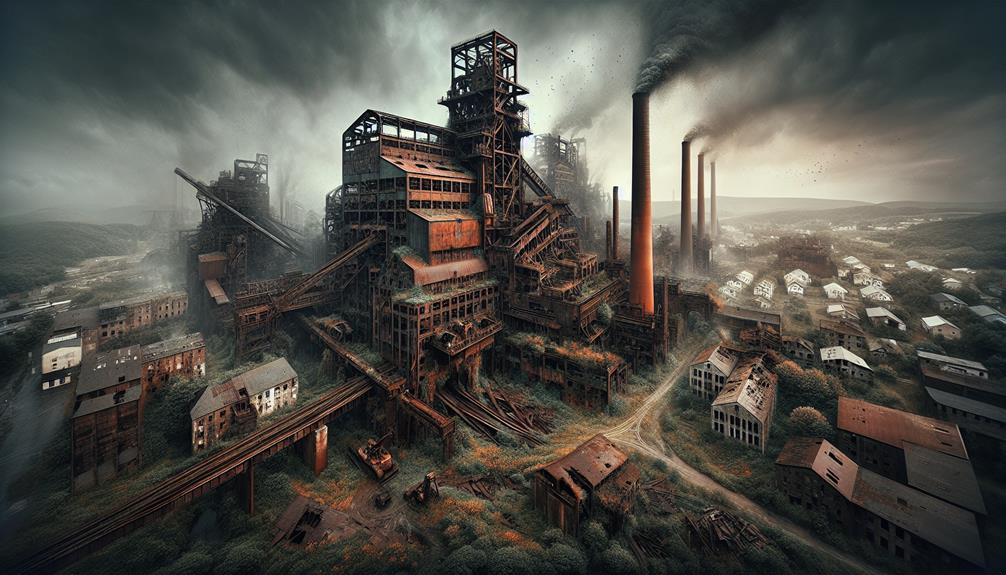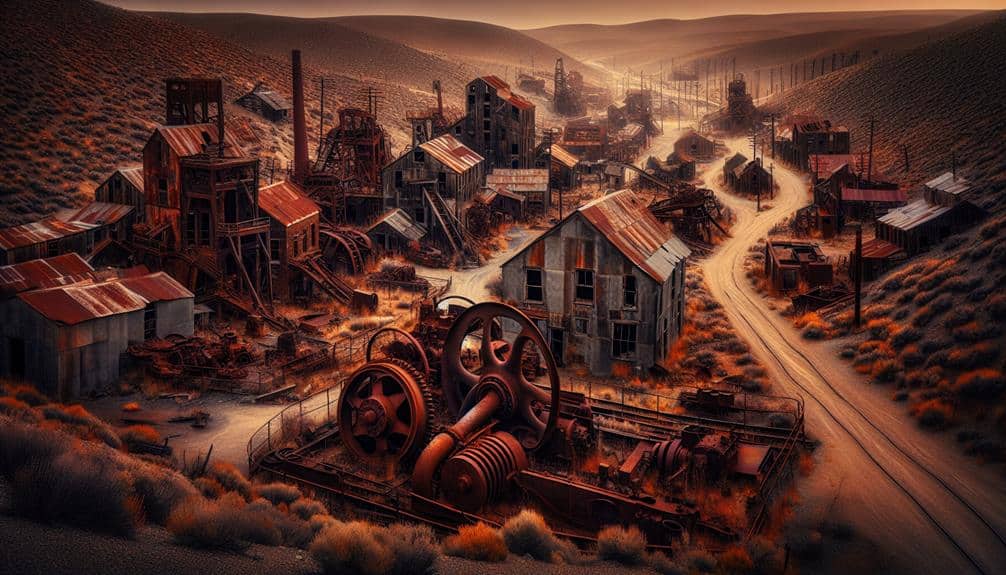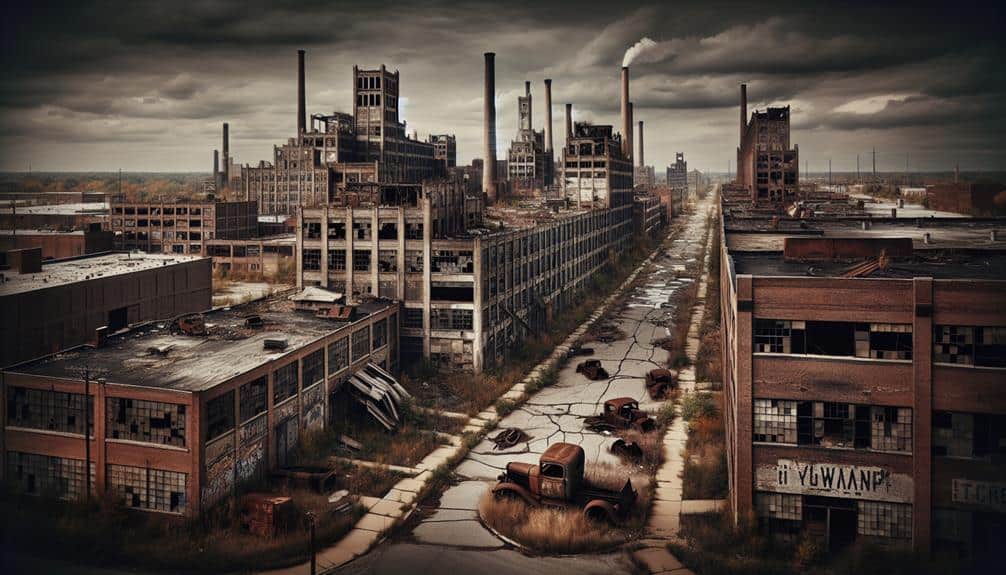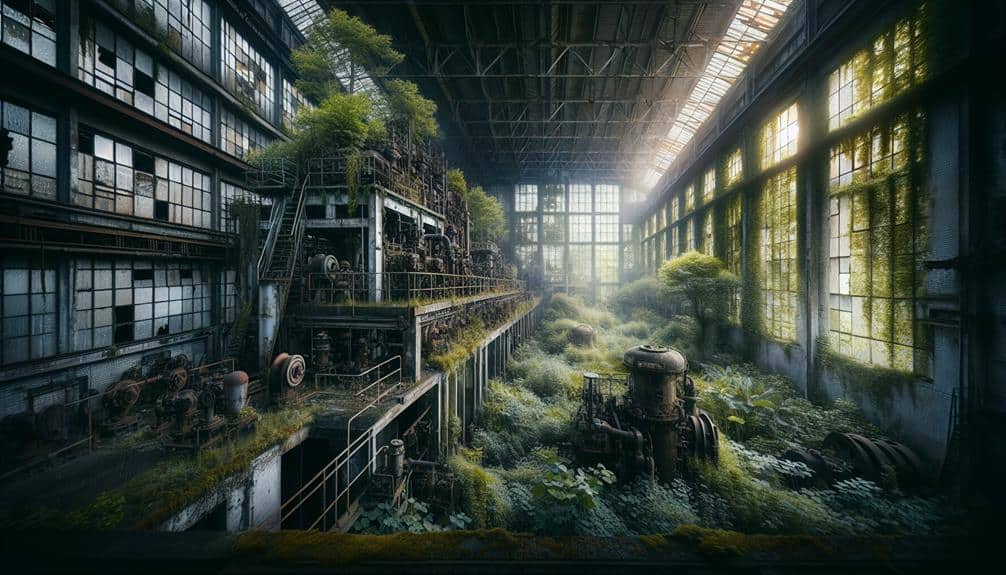Discover the top 7 abandoned steel mill towns in the US: Pittsburgh, PA; Birmingham, AL; Gary, IN; Bethlehem, PA; Lackawanna, NY; Joliet, IL; Homestead, PA. Each town tells a unique story of industrial rise and fall, with remnants still standing as evidence to their past glory. From the haunting beauty of rusting relics in Bethlehem to the resilient community spirit in Lackawanna, these towns offer a glimpse into America's industrial history and the ongoing efforts to preserve their legacy. Explore further to uncover the secrets these towns hold about their steel mill days.
Key Points
- Gary, Indiana: Once a thriving steel town, now abandoned due to economic challenges.
- Bethlehem, Pennsylvania: Historic steel town with remnants of industrial past.
- Joliet, Illinois: Abandoned steel mill sites reflect the town's industrial history.
- Lackawanna, New York: Revitalization projects repurpose old steel mill buildings.
- Homestead, Pennsylvania: Community efforts focus on repurposing old steel mill sites for modern use.
Pittsburgh, Pennsylvania
Pittsburgh, Pennsylvania, once a thriving hub of steel production, now stands as a poignant reminder of the decline of the industry in the United States. Steel industry innovations, such as the Bessemer process and the open-hearth furnace, propelled Pittsburgh into an industrial powerhouse during the late 19th and early 20th centuries. The city's transformation was remarkable, with mills and factories lining the rivers, fueling economic growth and urban development.
However, as the steel industry faced challenges like foreign competition and technological advancements, Pittsburgh's landscape shifted. The once vibrant mills now lay dormant, their towering structures casting shadows over the city. The decline of steel production in Pittsburgh not only affected the economy but also reshaped the social fabric of the community. Thousands lost their jobs, and neighborhoods that were once bustling with activity now echo with a sense of abandonment.
Despite these challenges, Pittsburgh has shown resilience and adaptability, evolving into a hub for technology, healthcare, and education. The city's metamorphosis serves as a reflection of the enduring spirit of its people, who've embraced change and forged a new identity beyond steel.
Birmingham, Alabama
Once a pivotal center of iron and steel production, Birmingham, Alabama, now stands as a demonstration of the industrial evolution and challenges faced by many American cities. Birmingham played a critical role in the Civil Rights Movement, with landmarks like the Birmingham Civil Rights Institute offering a poignant look into this pivotal time in American history. The city's museums, such as the Birmingham Museum of Art, showcase a rich tapestry of cultural heritage.
In addition to its historical significance, Birmingham offers a vibrant culinary scene, where you can indulge in delicious Southern cuisine at iconic establishments like Saw's BBQ. When the sun sets, the city comes alive with its eclectic nightlife, ranging from live music venues to cozy bars where you can unwind after a day of exploration.
Exploring Birmingham gives you a glimpse into the past while also highlighting its resilience and determination to thrive beyond its industrial roots. Whether you're interested in civil rights history, museums, southern cuisine, or vibrant nightlife, Birmingham has something to offer every visitor.
Gary, Indiana
Gary, Indiana, once a bustling hub of industry, now faces the challenges of urban decay due to the decline of its steel mills.
The city's industrial history is evident in its abandoned factories and neglected infrastructure.
Efforts to revitalize Gary are underway, aiming to breathe new life into this once-thriving steel town.
Garys Industrial History
The industrial history of Gary, Indiana, reveals a compelling narrative of rapid growth and transformation driven by the steel industry. Gary's decline began as the steel industry faced challenges, impacting the town's economy profoundly.
Once a thriving hub of steel production, Gary saw a downturn in the latter part of the 20th century, leading to a significant decline in industrial activities and employment opportunities. The impact of this decline reverberated throughout the community, affecting the livelihoods of many residents. Steel industry-related businesses closed down, contributing to Gary's economic struggles.
Despite these challenges, the remnants of Gary's industrial past stand as a symbol of its history, offering a glimpse into the town's once-vibrant industrial landscape.
Urban Decay Challenges
Amidst the remnants of its industrial past, Gary, Indiana faces significant urban decay challenges that have deeply impacted the town's landscape and community. Urban blight pervades the once-thriving city, with abandoned buildings, deteriorating infrastructure, and high crime rates contributing to a sense of neglect.
Despite these challenges, community resilience shines through as residents work diligently to combat the effects of urban decay through grassroots initiatives and neighborhood revitalization efforts. Historical preservation plays an essential role in preserving Gary's heritage, offering glimpses into its industrial zenith while also highlighting the stark realities of its decline.
Additionally, the town's tourism potential remains untapped, awaiting innovative strategies to leverage its unique history and architecture for economic revitalization.
Revitalization Efforts Underway
Facing the challenges of urban decay head-on, Gary, Indiana is currently witnessing a surge in revitalization efforts aimed at rejuvenating its once-thriving community and infrastructure. The city has embraced green initiatives to promote sustainability and environmental consciousness. Through community engagement, residents are actively participating in shaping the future of Gary.
Initiatives such as urban gardening, renewable energy projects, and brownfield redevelopment are transforming vacant lots and abandoned spaces into vibrant community hubs. By fostering a sense of ownership and pride among its citizens, Gary is laying the foundation for a brighter tomorrow.
As the city continues to prioritize revitalization, the synergy between green initiatives and community engagement is proving to be instrumental in driving positive change and revitalizing this historic steel town.
Bethlehem, Pennsylvania
Bethlehem, Pennsylvania holds a rich industrial history dating back to the early 1900s when it was a bustling steel mill town. The economic impact of the decline of the steel industry can still be felt today, with many residents facing economic challenges.
Efforts to preserve Bethlehem's historic buildings and revitalize the economy are currently underway to breathe new life into this once-thriving industrial hub.
Industrial History of Bethlehem
With its origins dating back to the early 18th century, Bethlehem, Pennsylvania, played a pivotal role in the industrial history of the United States. Bethlehem's steel industry boomed in the mid-19th century, transforming it into a major hub for steel production. The city's strategic location near key transportation routes made it an ideal site for industrial growth.
Bethlehem Steel Corporation, founded in 1857, became one of the largest steel producers in the country, supplying materials for iconic structures like the Golden Gate Bridge and Rockefeller Center. The industrial transformation of Bethlehem brought prosperity to the region, attracting workers from diverse backgrounds seeking employment opportunities in the booming steel industry.
This period marked a significant chapter in the city's history, shaping its identity as an industrial powerhouse.
Economic Impact Today
The current economic landscape in Bethlehem, Pennsylvania, reflects a complex interplay of historical industrial heritage and modern challenges. Community resilience is evident through diversified economic initiatives, including a shift towards technology and healthcare sectors.
Social impact remains a focal point, with efforts to provide job training and support for displaced workers. Environmental sustainability practices are gaining traction, with brownfield redevelopment projects and a commitment to green energy sources.
Crucial preservation efforts are essential in maintaining the city's identity and attracting tourism. Despite the decline of the steel industry, Bethlehem showcases adaptability and innovation in fostering a new economic identity while honoring its past. This blend of tradition and progress contributes to the city's ongoing economic revitalization.
Preservation Efforts Underway
Amidst the evolving economic landscape of Bethlehem, Pennsylvania, current preservation efforts are actively preserving the city's industrial heritage while fostering sustainable development. Historic preservation plays an important role in maintaining Bethlehem's identity and honoring its rich history.
Community engagement serves as a driving force behind these preservation initiatives, encouraging local residents to actively participate in restoring and repurposing old steel mill buildings. By involving the community in decision-making processes and project implementation, a sense of pride and ownership is instilled, ensuring the longevity of these preservation efforts.
Through a combination of historical significance and modern sustainability practices, Bethlehem is paving the way for other industrial towns to embrace their heritage while looking towards a brighter future.
- Engaging the community in restoration projects
- Repurposing old steel mill buildings for modern use
- Fostering a sense of pride and ownership among local residents
Lackawanna, New York
Once a bustling industrial hub, Lackawanna, New York, now stands as a reflection of the decline of the steel industry in the United States. Located near Buffalo, Lackawanna's steel mills were once a significant economic driver, but as the industry waned, the town faced a period of economic hardship.
However, in recent years, Lackawanna has witnessed a resurgence through revitalization projects aimed at preserving its cultural heritage. These projects have focused on repurposing old industrial sites into mixed-use spaces that honor the town's history while providing modern amenities.
The preservation of Lackawanna's cultural heritage has been a priority, with initiatives to conserve historic buildings and landmarks that tell the story of its industrial past. By embracing its history and finding innovative ways to repurpose abandoned steel mill sites, Lackawanna is carving out a new identity while paying homage to its roots.
Joliet, Illinois
In the heart of Illinois lies Joliet, a city that has seen its fair share of transformations due to its historical ties to the steel industry. Once a bustling hub of steel production, Joliet now stands as a demonstration of the evolution of industrial towns in America.
Abandoned infrastructure: Walking through Joliet, you'll come across remnants of its steel mill days – abandoned factories, rusting machinery, and empty warehouses that echo with the sounds of a bygone era.
Historical preservation efforts: Despite the decline of the steel industry, Joliet has made significant strides in preserving its heritage. The city has turned some old industrial sites into museums and parks, allowing visitors to experience the history firsthand.
Community resilience: While the steel mills have long been silent, the spirit of Joliet's residents remains strong. The community has adapted to new economic realities, diversifying its industries and embracing the future while honoring its past.
Homestead, Pennsylvania
Homestead, Pennsylvania, stands as a poignant example of a once-thriving steel town now grappling with the remnants of its industrial past. The steel industry played a significant role in shaping the identity of this community, attracting workers and their families seeking employment and a better life. However, as the industry declined, Homestead faced economic challenges and a dwindling population.
In recent years, efforts towards community revitalization have been evident in Homestead. The town has seen initiatives aimed at repurposing old steel mill sites into commercial and residential spaces, breathing new life into the area. These projects not only preserve the town's history but also provide opportunities for growth and development.
Despite the struggles faced by Homestead, there's a resilient spirit among its residents. The town's journey from a steel powerhouse to a community focused on revitalization showcases the determination and perseverance of its people. Homestead, Pennsylvania, serves as a reminder of the impact of industrial decline and the possibilities that lie in community-driven efforts towards renewal.
Frequently Asked Questions
What Are Some Popular Tourist Attractions Near the Abandoned Steel Mill Town of Pittsburgh, Pennsylvania?
When visiting the abandoned steel mill town of Pittsburgh, Pennsylvania, you can explore nearby attractions like the Andy Warhol Museum and Phipps Conservatory. Enjoy diverse dining options and immerse yourself in the local culture and entertainment scene.
How Has the Local Economy Been Impacted by the Closure of the Steel Mills in Birmingham, Alabama?
The shutdown of the steel mills in Birmingham, Alabama has greatly affected the local economy. The loss of jobs had a direct impact on the workforce, leading to challenges in community development and economic growth.
Are There Any Efforts Being Made to Revitalize the Abandoned Steel Mill Town of Gary, Indiana?
Efforts are being made to revitalize Gary, Indiana, a once-thriving steel mill town. Community initiatives, urban renewal projects, and investment opportunities aim to breathe new life into the area, fostering growth and prosperity.
What Historical Landmarks Can Be Found in the Abandoned Steel Mill Town of Bethlehem, Pennsylvania?
As you explore Bethlehem, Pennsylvania, you'll encounter a blend of historical architecture and cultural heritage. The town boasts landmarks like the iconic Bethlehem Steel Stacks, Steelworkers' House, and the Moravian settlement, each preserving a unique story.
What Is the Current Population Demographics of Lackawanna, New York, Following the Decline of the Steel Industry in the Area?
Lackawanna, New York's current population reflects a significant decline post-steel industry era. The economic impact in Lackawanna has been profound, shaping the town's demographics. As industries moved, residents followed, leading to shifts in population composition and dynamics.



